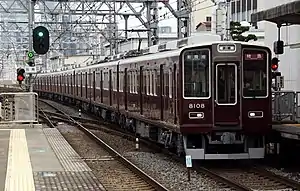Hankyu 8000 series
The Hankyu 8000 series (阪急電鉄8000系) is an electric multiple unit (EMU) train type operated in Japan by the private railway operator Hankyu Railway since 1989.[2]
| Hankyu 8000 series | |
|---|---|
 The first refurbished set, set 8008, in June 2020 | |
| In service | 1989– |
| Manufacturer | Alna Kōki |
| Replaced | 2000 series, 3100 series, 5200 series and damaged by the 1995 Great Hanshin Earthquake |
| Constructed | 1988–1993, 1996, 1997 |
| Refurbished | 2020– |
| Number built | 98 vehicles (19 sets) |
| Number in service | 98 vehicles (19 sets) |
| Formation | 2/8 (formerly 6) cars per trainset |
| Operator(s) | Hankyu Railway |
| Depot(s) | Hirai, Nishinomiya |
| Line(s) served | Hankyu Kobe Main Line Hankyu Kobe Kosoku Line Hankyū Takarazuka Main Line Hankyu Minoo Line Nose Railway Myōken Line Nose Railway Nissei Line |
| Specifications | |
| Car body construction | Aluminium alloy |
| Car length | 19,000 mm (62 ft 4 in) |
| Width | 2,750 mm (9 ft 0 in) |
| Height | 4,095 mm (13 ft 5.2 in) |
| Doors | 3 pairs per side |
| Maximum speed | 115 km/h (70 mph) |
| Traction system | Variable frequency GTO IGBT (Sets 8001, 8002, 8004, 8005, 8008) |
| Traction motors | Induction motors Brushless electric motors (PMSM) (Sets 8001, 8002, 8004, 8005, 8008) |
| Power output | 170 kW (230 hp) per motor[1] |
| Acceleration | 2.6 km/h/s |
| Electric system(s) | 1,500 V DC overhead catenary |
| Current collection method | Pantograph |
| Bogies | FS-369A, FS-069A SS-139A, SS-039A (Sets 8040 to 8042) |
| Braking system(s) | Regenerative brake Electronically controlled pneumatic brakes |
| Safety system(s) | ATS |
| Coupling system | Shibata-type (Type Mc8000/Tc8150) Knuckle-type (Type Mc8100) |
| Multiple working | 6000 series, 7000 series, 8200 series, 9000 series |
| Track gauge | 1,435 mm (4 ft 8 1⁄2 in) |
Formations
As of 1 April 2012, the fleet consisted of ten eight-car sets and nine two-car sets.[3] Some of the two-car sets are semi-permanently coupled with 6-car 7000 series sets.[3] Six-car sets were also operated initially, but these were subsequently lengthened to become eight-car sets.[2]
8-car sets
| Car No. | 1 | 2 | 3 | 4 | 5 | 6 | 7 | 8 |
|---|---|---|---|---|---|---|---|---|
| Designation | Mc1 | M2 | T1 | T2 | T2 | T1 | M1 | Mc2 |
| Type | Mc8000 Mc8000-2 | M8600 M8600-1 | T8550 | T8750 | T8750 | T8550 | M8500 M8500-1 | Mc8100 Mc8100-1 |
| Numbering | 8000 | 8600 | 8550 | 8750 | 8780 | 8650 | 8500 | 8100 |
- The "Mc1" and "M1" cars are each fitted with two scissors-type pantographs.[3]
- The "Mc1" and "M1" cars of set 8008 are each fitted with two single-arm pantographs.[3]
- Car 5 of set 8020 is numbered 8670 (type T8550), and car 6 is numbered 8790 (type T8750).[3]
- Cars 7 and 8 of sets 8002 to 8007 include transverse seating.[3]
Sets 8030 to 8035
| Car No. | 1 | 2 |
|---|---|---|
| Designation | Mc1 | Tc |
| Type | Mc8000 | Tc8150 Tc8150-1 |
| Numbering | 8030 | 8150 |
Sets 8040 to 8042
| Car No. | 1 | 2 |
|---|---|---|
| Designation | Mc1 | Tc |
| Type | Mc8000-1 | Tc8150-2 |
| Numbering | 8040 | 8190 |
The "Mc1" cars are fitted with two single-arm pantographs.[3]
 Set 8000 "classic 8000" livery, July 2019
Set 8000 "classic 8000" livery, July 2019 8000 series second build train, May 2020
8000 series second build train, May 2020 8000 series third build train, May 2020
8000 series third build train, May 2020
References
- Harris, Ken, ed. (2005). Jane's World Railways 2005-2006 (47th ed.). Jane's Information Group. p. 291. ISBN 0 7106 2710 6.
- 私鉄車両年鑑2012 [Japan Private Railways Annual 2012]. Tokyo, Japan: Ikaros Publications Ltd. February 2012. p. 71. ISBN 978-4-86320-549-9.
- 私鉄車両編成表 2012 [Private Railway Rolling Stock Formations - 2012]. Japan: JRR. July 2012. pp. 136–138. ISBN 978-4-330-29911-2.
| Wikimedia Commons has media related to Hankyu 8000 series. |
This article is issued from Wikipedia. The text is licensed under Creative Commons - Attribution - Sharealike. Additional terms may apply for the media files.
